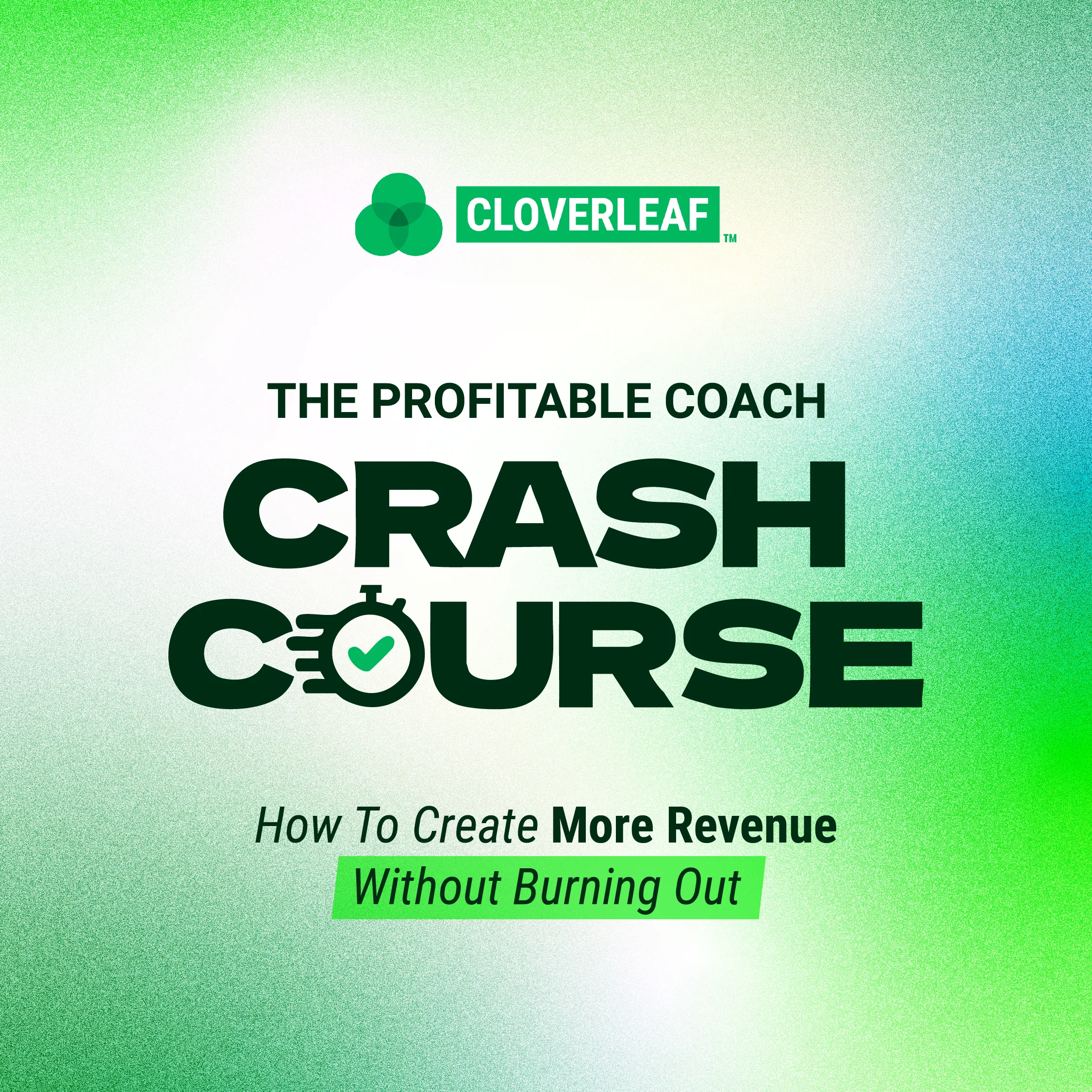Most Executive Coaches Want to Scale. But Most Models Trade Depth for Reach.
Every executive coach reaches that moment.
Your calendar is full. Your clients love the work. But scaling feels impossible without giving something up—your time, your presence, or your standards.
And if you’ve ever searched how to scale a coaching business, you already know what’s out there:
Build a course. Launch a group. Create a funnel. Hire a team.
These models can work—but they weren’t built for what you do.
Because you’re not selling information. You’re facilitating transformation.
You’re not creating content. You’re coaching behavior.
And that requires a different kind of scale—one that doesn’t demand more hours, but delivers more value.
This article is about that kind of scale.
You’ll learn how to grow your coaching business in a way that:
- Deepens the client experience, not dilutes it
- Keeps you top-of-mind—even when you’re not in the room
- Turns your insights into everyday action, not just session notes
- And helps you serve more people with the same presence and quality you’re known for
We’ll reframe growth not as stepping away from clients—but as extending your impact across more of their day, their team, and their business.
And we’ll show you how to do it with tools that reinforce your work, not replace it.
Let’s start with why most coaches hit a wall when trying to scale—and how to build a business that doesn’t burn you out.
Get the High Impact Coach Crash Course to see how to build a coaching business that delivers more value, serves more clients, and grows more revenue without burning you out.
Why Most Coaches Get Stuck When Trying to Scale
If you’ve ever tried to grow your coaching business, you’ve probably heard some version of this advice:
“Stop coaching. Start creating. Build a course. Launch a group program. Scale your content.”
It sounds logical—especially if you’re burned out from back-to-back sessions.
But here’s the problem: that advice is built on a faulty assumption.
It treats coaching like content. Like your job is to deliver information that can be packaged, automated, and sold at scale.
But if you’re an executive coach, information isn’t your product.
You’re not just providing insight—you’re creating transformation. And that transformation doesn’t come from passive content. It comes from a combination of presence, trust, thoughtful application, and reinforcement over time.
This is where most coaches hit the ceiling.
It’s not because there isn’t demand. It’s because the business model relies too heavily on you being in the room:
- You’re the one guiding the insight
- You’re the one reinforcing the learning
- You’re the one carrying the momentum between sessions
And as your calendar fills, that model breaks. There’s no room to scale—not because your value is limited, but because it’s been built around your availability, not your capability.
So, growth becomes a choice between working more hours or pulling yourself out of the work entirely.
And neither feels right.
What’s missing is a third path—one where your coaching keeps showing up without you needing to be everywhere at once.
That’s what real scale looks like. And it’s possible—if you shift the model. It comes from designing strategies that can extend your coaching and make your impact stick.
The Real Cost of Scaling That Pulls You Away From the Work
When the coaching industry talks about scale, the conversation often shifts toward removal:
- Remove yourself from delivery.
- Remove live interaction.
- Remove the hours you spend with clients.
The logic makes sense—at first. More leverage, less time.
But when the solution becomes pulling the coach out of the coaching, something essential is lost. Because when you disappear, so does the depth.
Scaling coaching doesn’t mean watering it down. It means being intentional about how people engage, learn, and grow together.”
True scale isn’t about doing less—it’s about designing better experiences that allow transformation to continue even when you’re not live with the client. This includes everything from group reflection exercises to coaching nudges that reinforce key insights.
Scale that looks efficient on paper but falls flat in practice:
- Clients disengage after the kickoff.
- The coaching becomes transactional, not transformational.
- The growth you sparked in the session fades by Monday.
Workbooks don’t prompt behavior change. Static assessments don’t reinforce insights.
Coaching that’s siloed to a single moment—or locked in a resource library—simply doesn’t stick.
What clients need isn’t more worksheets or dashboards.
They need more of the coaching experience, applied in the flow of their real work.
The answer isn’t to strip the coach away.
It’s to build systems that extend the coach’s presence—so your insights show up when they’re needed most, even if you’re not in the room.
That kind of presence doesn’t require constant effort—it requires smart systems that reinforce what you already taught.
Yes, automation can feel impersonal. But when it’s grounded in real insight and delivered in the moments people actually need it, it can feel like the coach is right there—supporting the decision, reframing the conflict, or nudging a leader to pause before reacting.
It’s not just scalable—it’s personal, because it’s based on how your clients think, lead, and relate.
Automation doesn’t have to mean detachment. Done well, it can make your coaching feel even more personal, relevant, and present.
Imagine a nudge that shows up in a client’s inbox minutes before a 1:1—reminding them how their teammate prefers feedback. Or a tip that helps them manage a tough conversation based on their Enneagram type. Or a prompt that builds on the mindset you introduced in your last session.
That’s how you scale without sacrificing relevance, retention, or your human touch.
Shift your coaching business from hourly billing to predictable revenue
Ready to finally move beyond hourly limits? Let’s start building your profitable coaching business today

What a Scalable Coaching Business Actually Looks Like
Most “scaling strategies” in coaching start with subtraction:
Less presence. Fewer sessions. Reduced interaction.
A scalable coaching business doesn’t rely on how many hours you can offer.
It’s built on how effectively your insight continues to show up—even when you’re not in the room.
That means building a model where:
Your insights don’t disappear when the Zoom ends
Clients remember what they learned because it’s reinforced daily.
Your coaching can integrate into your client’s workflow
Nudges in inboxes, tips in calendars, and insights in Slack to ensure your coaching remains actionable and contextually relevant.
Your clients feel the impact every day, not just Thursdays at 3 pm
Coaching becomes part of how they lead, decide, and collaborate.
This is what coaching looks like when it scales with depth.
It becomes sticky. Visible. Shareable.
Not just a personal development tool, but a leadership strategy that’s felt across the team.
And when your coaching shows up every day—in meetings, inboxes, and decisions, it doesn’t just deepen value. It creates visibility across the organization.
That visibility leads to:
- Extended contracts, because clients experience consistent progress, not just peaks during sessions
- Cross-team expansion, as other leaders see the impact firsthand
- More strategic partnerships, because your work aligns with org-wide priorities
And as your insights become embedded in how people work, not just how they reflect, your coaching becomes indispensable.
Indispensable services don’t get cut. They get scaled.
That’s when coaching shifts from a service to a scalable growth engine—without sacrificing what makes it powerful.
That’s the power of coaching that scales with depth and presence, not just productivity.
You don’t need to chase new clients every quarter.
You deepen relationships, increase visibility, and become a long-term partner.
Because when coaching drives how teams operate, not just how individuals think, it becomes essential to the business.
And that’s when your business starts growing with your impact, not against your time.
How Coaches Are Using AI-Powered Coaching to Scale With More Presence, Not Less
Let’s name the tension:
Automation can feel impersonal.
Generic. Robotic. Disconnected from the human relationship, coaching is built on.
That’s valid. Many tools churn out surface-level tips that sound like they were written by a bot, because they were.
Cloverleaf does it differently.
The nudges aren’t AI-generated. They’re AI-delivered.
Every insight comes from content written by experienced coaches, behavioral scientists, and assessment experts. AI is the delivery system—not the author.
The result? Clients don’t feel coached by a machine.
They feel supported by you, at the right moment, with the right insight.
Here’s how it works:
🧩 Assessment layering
Most tools offer one lens. Cloverleaf combines multiple: DISC, Enneagram, MBTI/16 Types, Strengths, and more. That means richer insight delivered in a format clients actually use.
💬 Coaching nudges
Insight fades without reinforcement. Cloverleaf delivers timely, personalized coaching tips where your clients already work—inside email, Slack, or Microsoft Teams. You don’t have to chase the follow-up. The insight shows up for them.
📊 Coach dashboards
You can see what’s resonating. Who’s engaging. What topics are getting traction. It’s not about surveillance—it’s about knowing where your coaching is landing, so you can build on it.
🔐 Coach-first AI
You stay in control. Cloverleaf serves as an extension of your expertise, enhancing your coaching by providing continuous, personalized support that aligns with your clients’ evolving needs. Every insight delivered reflects the strategy you put in motion.
Scalable Coaching In Action
Scaling your coaching business doesn’t require launching a course or building a massive following. With the right tools, you can extend your reach and impact without overextending yourself.
Real scale is when your coaching creates momentum, even when you’re not in the room.
Here’s what that looks like in practice:
🔁 Staying Top of Mind = Repeat Business
One coach ran a single team workshop for a leadership offsite. Normally, that would’ve been the end of the engagement.
But because every team member started receiving daily Cloverleaf nudges tied to what they learned, the coach’s insight stayed present.
Months later, the client brought her back—not just for another workshop, but for an extended contract across multiple teams.
It was the easiest re-engagement I’ve ever had. I didn’t need to pitch. They’d already been using the insights every day.
👶 Maternity Leave With Confidence, Not Chaos
Another coach used Cloverleaf to support a high-performing sales leader preparing for maternity leave.
She was anxious—unsure how she’d stay connected, whether her team would shift without her, or how she’d reenter with confidence.
With coaching nudges tailored to her style and her team’s personalities, she stayed plugged in—without having to check in.
Cloverleaf helped my client stay connected during maternity leave—because she kept getting insights tailored to her team. She came back with confidence, not chaos.
⚡ Turning Team Tension Into Trust
One coach was brought in to work with a leadership team that had been through a rocky reorg.
The group had completed assessments, but hadn’t seen each other’s results. Conversations were tense, feedback was personal, and collaboration was low.
The coach facilitated a session using a Cloverleaf dashboard. With shared visibility into personality types and communication preferences, the conversation changed immediately.
Tension dropped. Curiosity replaced blame. Suddenly, team members weren’t reacting to each other—they were responding to insight.
Cloverleaf depersonalized the conflict. It gave us a language to talk about tension without turning it into drama.
Scaling with Cloverleaf means you can reach thousands, but with coaching that still feels personal, relevant, and behavior-focused.
What This Means for Your Business
Scaling your coaching business doesn’t require stepping away from what makes you great.
It requires systems that make your insight more present, even when you’re not.
Here’s what’s possible:
You Can Show Up Consistently—Between Sessions
Your clients don’t just remember you when you’re on Zoom.
With tools like Cloverleaf, your voice shows up in their inbox, meetings, and decisions—every single day.
You Can Deepen Your Value Across Teams
When coaching becomes part of team dynamics, not just individual development, it stops being seen as a perk.
It becomes part of the performance infrastructure.
You Can Grow Recurring Revenue—Because Clients Stay in the Work
When insights are reinforced daily, clients don’t just remember your coaching, they rely on it.
That kind of consistency builds trust, deepens transformation, and keeps your coaching top-of-mind between sessions.
And the result?
- Longer-term engagements
- More referrals
- More strategic investments in your work
You’re not just selling sessions. You’re offering an experience clients don’t want to lose.
You Can Become a Strategic Partner (And Unlock New Growth)
When your coaching drives team alignment, leadership capacity, and culture change, you stop being seen as a personal advisor.
You become a business asset.
That opens the door to:
- Leading org-wide leadership programs
- Supporting change management initiatives
- Partnering with HR or L&D on long-term development strategy
Instead of selling one engagement, you’re invited into the broader strategy, because your work touches every level of the organization.
Scale Doesn’t Require Doing More
You don’t need to launch a course, hire a team, or build a membership to grow.
You can, but you don’t have to.
The real opportunity is in building a business that scales your presence, not just your calendar.
When your coaching reinforces behavior change…
When your insights show up between sessions…
When your value is felt daily, not just weekly…
That’s when clients stay. Teams grow. And your coaching becomes essential.
Because scale doesn’t mean doing more.
It means making what you already do well go further.
👉 Want to scale your coaching without burning out—or becoming just another course creator?
See how Cloverleaf helps coaches reinforce insights, stay present between sessions, and grow their business without adding more hours.
🙋 FAQ
Q: Does this replace the coach?
A: No. Cloverleaf extends your insight—it doesn’t automate your presence. You stay in control of the coaching experience, while the platform reinforces what matters between sessions.
Q: Will this feel impersonal to my clients?
A: Only if the technology is generic. But with Cloverleaf, every nudge is based on the assessments, coaching goals, and team dynamics that you’ve helped shape.
Clients don’t get canned content—they get timely, relevant insights that reinforce your strategy, in the tools they already use (email, Slack, calendars).
It’s not automation that replaces you. It’s automation that extends you—making your coaching show up when it matters most.
Q: What if I only coach individuals—does this still apply?
A: Absolutely. Whether you’re supporting one leader or scaling across a team, Cloverleaf helps you show up more often, with less effort—growing your impact and visibility across the organization.






